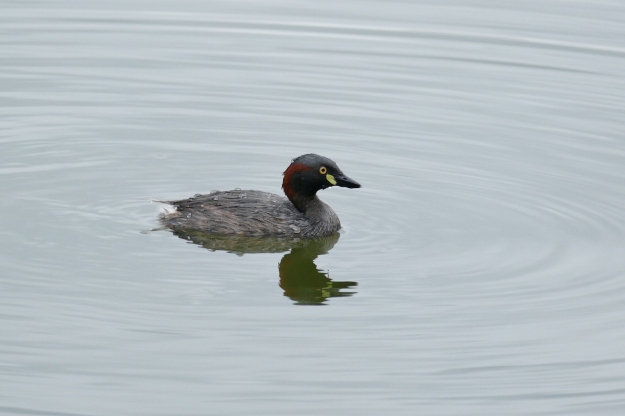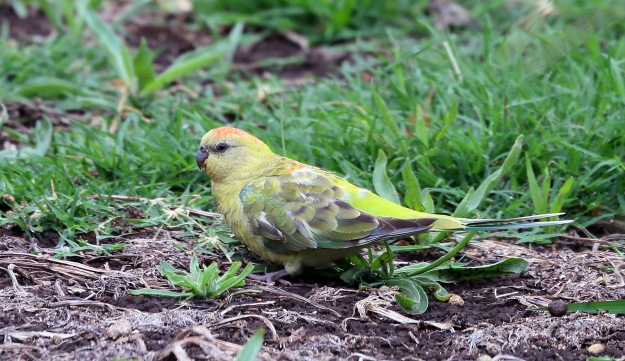By Anthea Fleming
It is always a pleasure to share my enthusiasm for these parks in the City of Banyule. I have known them all my birding life and I learnt my birds there. Since 1970 I have seen many changes, and participated in many plantings with the Warringal Conservation Society. I must also commend Banyule Council’s Bushland Management Team who care for these reserves.
We met at 8.00 am at Banyule Flats, beginning with the Tawny Frogmouth family near the car-park. The parents were up on a high branch, Junior still on the old wattle. Every visitor photographs them: so did we. We then moved off to the Banyule Swamp, leaving the recently re-filled Billabong behind its screen of ancient Red Gums and younger under-storey (established from 1989 on) on our left, to make our way to the Swamp. The Swamp is an old one, but enlarged by the Banyule Council in 1999. Banyule Homestead, built 1848, overlooks it. The Swamp is currently full, but most water-birds are away, enjoying inland floods. The regulars – Dusky Moorhens and European Coots, and a solitary Swamp-hen were seen; a single Hardhead had joined the Chestnut and Grey Teal and Black Ducks. Australasian and Hoary-headed Grebes appeared. A few Wood Ducks flew in for a refresher – a large flock has been grazing the newly re-sown oval nearby. The big dead trees are always worth checking – as well as a young White-faced Heron and a Little Pied Cormorant, we found a flock of Red-rumped Parrots.
We crossed mown grassland west of the Billabong, and instantly found some Red-rumps feeding in the barer patches. We were all very interested in the ‘yellow bird’ which is obviously an aberrant Red-rump – very amenable to photography.
We also found a group of Eastern Rosellas, seldom seen here these days. Then round the end of the Billabong to the South Paddock and the banks of the Yarra. The understorey has regenerated well since the cattle-grazing days – some natural, some planted – and we saw White-browed Scrub-wrens, Brown Thornbills, and Superb Fairy-wrens (which I still call Blue Wrens). There were no birds on the river, very muddy and fast after recent rain, but there were Yellow-faced Honeyeaters in the canopy, hard to pick against a grey sky. We had the same trouble with Mistletoe-birds when we reached the Windmill, but fortunately they came to a large Silver Wattle with a lot of Grey Mistletoe, by the gateway.
We were now on part of the Yarra Valley Park, which receives less intensive management; weeds such as Hawthorns and Kapok Vine are present on the Billabong margins. We saw Grey Butcherbirds, Black-faced Cuckoo-shrikes and a Grey Shrike-thrush in the tree-tops, but still against a grey sky. At the Main Yarra Trail we turned right to go upstream. The sun came out and Sulphur-crested Cockatoos screeched at us. The magnificent old River Red gums along the bank were admired – they were full of hollows, including some apparently occupied by Striated Pardalotes. White-plumed Honeyeaters and Grey Fantails were also in the canopy. We followed a narrow goat-track much used by cyclists, which re-joined the Main Trail at the Plenty Foot-bridge. The Plenty was flowing strongly.
Some stalked a Common Bronzewing and others photographed a group of Rainbow Lorikeets which were gobbling Tree Violet berries in a conveniently low shrub. The birds often hung head-down as the slender twigs bent under them. We returned along the main trail, pausing at the only place where there is a view of the Billabong. After it had been dry for several years, Melbourne Water pumped water in from the River during early December, to the delight of myriads of frogs. A duck left hastily as we arrived, but there are still too many emergent dead weeds for a good view. I have recently seen ducks, Dusky Moorhens, grebes and White-faced Heron there, but how long the water will last we do not know. Back to the cars, and most people moved off for Wilson Reserve, though some were seen heading off to investigate the ‘Grotty Pond’.
Wilson Reserve, quite an old park, began where an old road reserve gave public access to the river-bank through private farmlands. One of Victoria’s first Boy Scout groups camped and built a den here, from 1910, and a sand beach was very popular for swimming and boating. In 1924 the land was bought by public subscription and presented to Heidelberg Council “for the youth of Ivanhoe”. “Skipper” Wilson of the First Ivanhoe Sea Scouts gave his name to the Reserve and another tireless worker, Chris Bailey, is commemorated in the Bailey Billabong.
After lunch, and the Banyule Flats Bird Call, we were pleased to meet a Common Bronzewing as we left the car-park. We first went on to the Point, to inspect the site where Powerful Owls and their offspring have often been seen in late spring, among the exotic Box-Elder trees and Poplars, but not today. When we returned to the disused concrete Scout Den, the Bronzewing was feeding on the flat roof. Photography was possible with a special effort!
We wandered upstream on the riverbank track, with assorted small birds such as Silvereyes and Scrubwrens in the dense understorey of Tree Violet, Native Hemp, and Coprosma quadrifida (alias Native Currant). There were still a few red berries to see, with a Red Wattlebird gleaning the last. We were pleased to see a Willy Wagtail, singing boldly. The abundant Tradescantia weed was less welcome, but the Friends of Wilson Reserve have made a splendid effort to clear and re-plant in many areas. We walked upstream along the track behind the Ivanhoe Golf-course, as far as the Horseshoe Billabong, which had been recently filled by a flash flood. Chestnut Teal had moved in.
River Bottlebrush and a rare shrub, Muttonwood, are indicators of how unmodified this riverine bush is, once weeds are controlled. A Yellow Robin was seen. Back to the track around the Billabong, and out onto the Chelsworth Park area by the Oval. Here there is a fine view of the Billabong, with Moorhens and a single Swamp-hen patrolling the bank. We crossed to the Reedy Billabong, where we had an opportunity to see and photograph the Bell Miners – dense growth enables them to withstand the Noisy Miners.
Back at the car-park, we met the Bronzewing again, in more co-operative mood – we all got photos. Then a pause for the Bird List – not so many species here, but Yellow Robin, Willy Wagtail and the Bell Miners as locals. Perhaps it was really too late in the day at Wilson Reserve, but we were very fortunate in the weather, and I believe we had a good introduction to two fine birding areas.
bpg-list-banyule_wilsons-20170121
Site Access Details:
Banyule Flats Reserve, carpark off Somerset Rd, Viewbank (-37.748900, 145.089339; Melway 32 F2)
Wilson Reserve, The Boulevard, Ivanhoe (-37.778814, 145.044250; Melway 31 G10)










